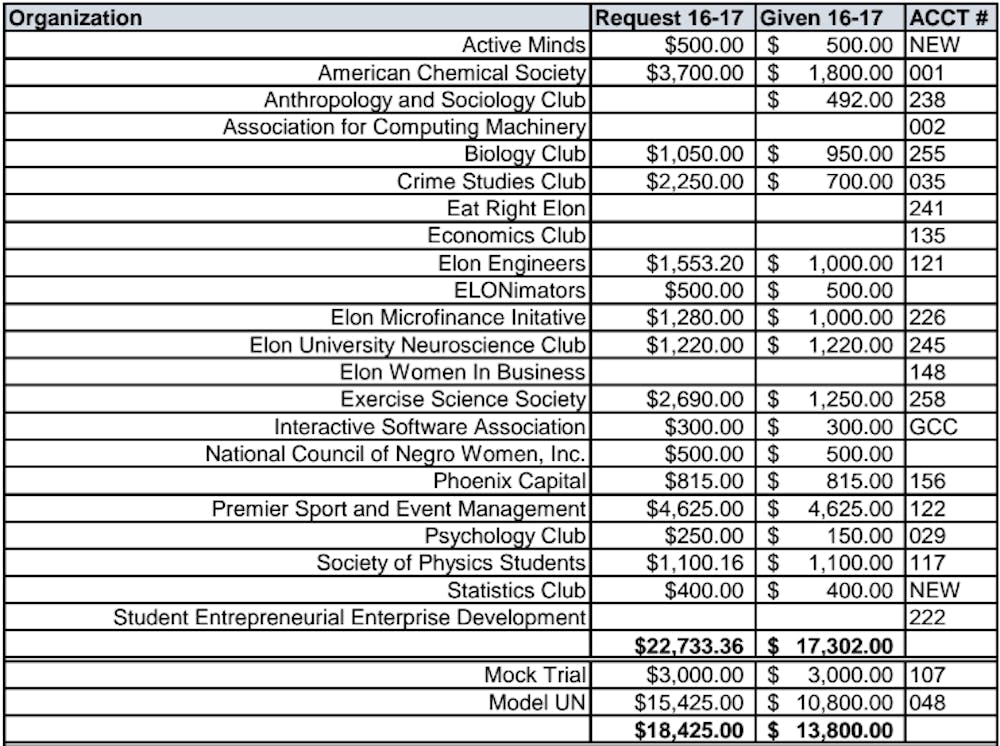At first glance, the trend of the 2016-2017 budget is not a good one. Most of the organizations did not receive the amount they requested, and 35 out of 60 organizations were denied $1,000 or more of their asking price. But despite the gap between asking amount and amount received, many organizations saw an overall increase in funding.
The Student Union Board saw its allotted funds surge from $129,233 to $135,753, while The Black Student Union saw its funds rise from $7,000 to $9,000. Yet even with the evident boosts in these organizations’ accounts, most didn’t see the total amount requested.
Newlyelected SGA Executive President Kyle Porro said many organizations come and ask for large sums of money that the treasury simply can’t afford.
“SGA’s budget increases by about 5 percent each year, and a lot of these organizations come in and ask for double the amount or anything that’s more than the 5 percent we have,” Porro said. “It’s impossible because we don’t have that kind of money to give them.”
The total amount the SGA treasury could allocate to organizations this year was $652,000. The main factor of pinpointing who gets the most money is how involved the organization is on campus, which explains why SUB was given a monster sum of $135,753. Other factors include how long they have been on campus and how many members they have.
Executive Treasurer Eason Warren said any organization is welcome to negotiate with him if they feel undervalued, but he added that his office must follow strict guidelines.
“I would tell [the organization] to have them come talk to me,” Warren said. “But usually our budget is based on factual information.”
Even though most organizations are not granted all of the money they request, SGA attempts to allocate them enough money to work with. Every year, each organization treasurer sends an itemized budget to the cluster budget hearing.
Warren said the main reason organizations do not receive all of the requested amount is because SGA must follow the Treasurer’s manual, which outlines what SGA allows organizations to use its funds for, such as the number of people at national conventions, and money used for airfare, gas and lodging.
Warren said most of the blockage of money is because of what the manual says.
“A lot of organizations ask for stuff that SGA simply can’t pay for,” Warren said. “For example, one organization asked for money to give their members T-shirts and we can’t do that because we would be giving students free stuff. Another example is the gardening club asked us for $150 dollars to buy pots and resell them, and since they would make profit off of it, we can’t provide them with that.”
Porro agreed with Warren, saying the manual is binding and is very clear about what the Treasury is permitted to do.
“In an ideal world, we would give everyone the money they ask for,” Porro said. “But a lot of times it comes down to what the manual allows us to do.”
Because it is not practical to have every organization represented directly by one individual, a cluster is responsible for representing multiple organizations. Clusters are appointed by the Student Life Committee and vouch for their organizations during the budget hearings. They talk with organizations’ presidents to get a consensus about what they want to accomplish the following year. Porro says the cluster system is effective because it utilizes students who are familiar with multiple organizations to be advocates.
“We pick students who are involved heavily with their own organizations and the community as a whole,” Porro said. “Even if your club might not have someone who is represented, there will be someone who knows something about that organization to speak on its behalf.”
After each pitch is made, the financial committee, consisting of the executive treasurer, assistant treasurer and four class treasurers, compiles the budget. The SGA senate then votes on the finalized draft.


